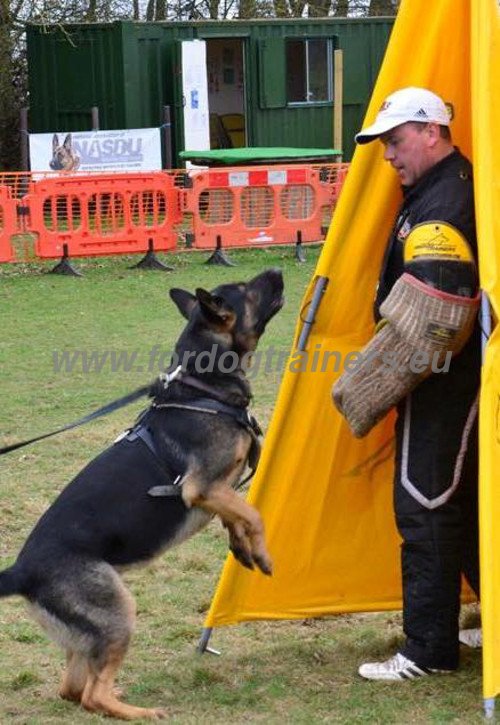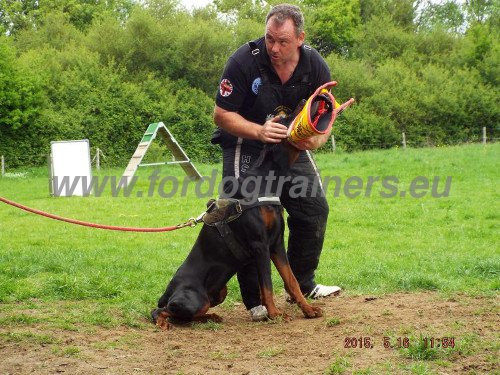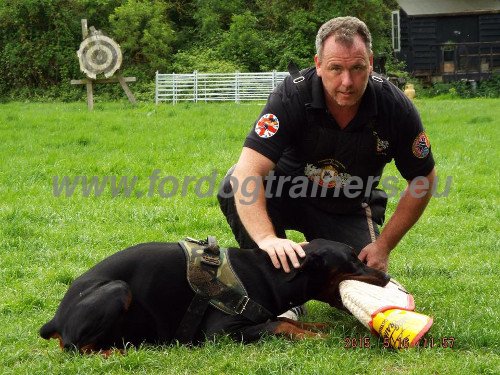Training a Dog for Attack: Counsel from Michale McCann
Attack Training with Professional Bite
Equipment

Seize with teeth, transfer, attack, attack with a rubber stick.
Initially, a dog is kept on a leash.
A trainer puts on a soft
protection sleeve. The first stage, or seize with teeth is
accomplished when the trainer is dressed in a protective
suit. The purpose of the exercise is to make the dog grab
the sleeve fully. At this stage, the main role is played by
trainer, bearing the full responsibility for successes and
failures.
When the dog grabs the sleeve, the trainer stretches his left hand
forward in order to ensure support for the animal. Here a
so-called transfer starts. The trainer pulls the dog making sure
that the dog does not release the
sleeve. The owner or the handler moves next to the dog and
encourages it, trying to keep the dog on a long leash to provide
it with maximum freedom of movement. If the dog shows good
fighting qualities, after a few sessions training with a hard
sleeve starts, consisting in the same exercises. 
The main thing is to hold the sleeve in a correct position,
necessarily horizontally - not too low and not too high,
approximately at the height of the hips. If the trainer is
right-hander, the sleeve is worn on the left arm. In this case, at
the moment of an encounter with the dog, the person should pull
his left arm back so that the dog does not strike against it and
does not hurt itself. The right arm should be stretched to the
right side in order to maintain balance.
After a few sessions the owner eases off the
leash, providing complete freedom for the dog. At the same
time he himself is always by its side. Each session always ends
with the dog seizing the
sleeve completely and receiving praise and encouragement
from its owner. The next step, namely the struggle, also depends
entirely on the skills of the trainer, who should move the sleeve
up and down, at first very slowly and gently, then more strongly.
The rate and nature of movement are selected depending of the
character and fighting spirit of the dog. Finally, the turn of
exercises with rubber stick or whip comes, with which the trainer
hits the dog during the fight. The trainer should be able to
choose the most opportune moment for the first stroke, so that the
dog would not release the object, not panic or slow down.
Stick stroke is applied at the moment when the dog teeth are
gripping firmly the sleeve and the animal shows a clear
willingness to fight. Stabbing, the trainer must not stand aside,
but should continue fighting in order to strengthen a militant
response of the dog. Only in a few moments can he give it the
sleeve. If after hitting the dog releases the object, one should
return to the pulling stage of training, or even to the seize with
teeth. At the same time, however, the trainer should not
relinquish the whip so that the dog gets used to it. 
It is however necessary to remember that the dogs with good
quenching simply ignores the stick strokes. Moreover, strokes move
them to grip the sleeve even more firmly. Therefore, if after a
stroke the dog weakens the pressure, or releases the sleeve
completely, it is almost always the trainer who is to blame, for
he chose the wrong moment to strike.